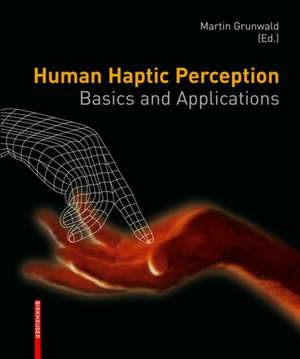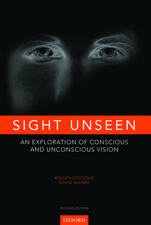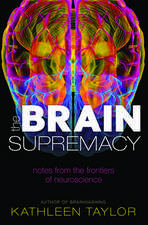Human Haptic Perception: Basics and Applications
Editat de Martin Grunwalden Limba Engleză Hardback – 17 oct 2008
An international team of 80 authors presents a comprehensive collection of writings on both aspects of research on human haptic perception.
After a theoretical and historical introduction, the chapters are dedicated to neurophysiological, psychological, clinical and neuropsychological aspects of haptic perception. Results of studies into human haptic perception in the fields of virtual haptics and robotics are also included. Finally, contributions from the applied and industrial sectors illustrate the practical uses of knowledge about the human sense of touch.
This easily accessible textbook gives not only students, scientists and those with prior knowledge, but also interested laypersons insights into a fascinating area of study.
Preț: 570.11 lei
Preț vechi: 703.84 lei
-19% Nou
Puncte Express: 855
Preț estimativ în valută:
109.10€ • 118.47$ • 91.65£
109.10€ • 118.47$ • 91.65£
Carte tipărită la comandă
Livrare economică 18-24 aprilie
Preluare comenzi: 021 569.72.76
Specificații
ISBN-13: 9783764376116
ISBN-10: 3764376112
Pagini: 600
Ilustrații: IX, 676 p. 238 illus.
Dimensiuni: 198 x 238 x 48 mm
Greutate: 1.51 kg
Ediția:2008
Editura: Birkhäuser Basel
Colecția Birkhäuser
Locul publicării:Basel, Switzerland
ISBN-10: 3764376112
Pagini: 600
Ilustrații: IX, 676 p. 238 illus.
Dimensiuni: 198 x 238 x 48 mm
Greutate: 1.51 kg
Ediția:2008
Editura: Birkhäuser Basel
Colecția Birkhäuser
Locul publicării:Basel, Switzerland
Public țintă
ResearchCuprins
Epistemological and historical aspects.- Haptic perception: an historical approach.- German pioneers of research into human haptic perception.- British pioneers of research into human haptic perception.- Early psychological studies on touch in France.- Haptics in the United States before 1940.- Neurophysiological and physiological aspects.- Anatomy of receptors.- Physiological mechanisms of the receptor system.- Neural basis of haptic perception.- The neural bases of haptic working memory.- Neuronal plasticity of the haptic system.- Psychological aspects.- Haptic perception in the human foetus.- Haptic behavior in social interaction.- Learning effects in haptic perception.- Implicit and explicit memory effects in haptic perception.- Attention in sense of touch.- Haptic object identification.- Haptic perceptual illusions.- Haptic perception in interaction with other senses.- Haptically evoked activation of visual cortex.- Haptic perception and synaesthesia.- Haptic perception in sexuality.- Haptic perception in space travel.- Clinical and neuropsychological aspects.- Phantom sensations.- The neuroscience and phenomenology of sensory loss.- Focal dystonia: diagnostic, therapy, rehabilitation.- Self-injurious behavior.- Haptic perception in infancy and first acquisition of object words: Developmental and clinical approach.- Haptic perception in anorexia nervosa.- Haptic interfaces and devices.- History of haptic interface.- Principles of haptic perception in virtual environments.- Haptic shape cues, invariants, priors and interface design.- Design guidelines for generating force feedback on fingertips using haptic interfaces.- Haptic rendering and control.- Haptic perception in human robotic systems.- Applications.- Haptic design of vehicle interiors at AUDI.- Visual-haptic interfaces in car design at BMW.- Haptics research at Daimler AG.- Haptic design of handles.- Vestibular sensory substitution using tongue electrotactile display.- The blind get a taste of vision.-Tactile ground surface indicators in public places.- HapticWalker — Haptic foot device for gait rehabilitation.- Haptic sensing of virtual textiles.- Haptic discrimination of paper.- Haptic banknote design.- Get touched — Bodycare as a design of media for self-perception.
Textul de pe ultima copertă
Active touch perception – also known as haptic perception – is of primary importance for the planning, direction and execution of everyday actions. This most complex of human sensory systems is gaining ever more importance for various scientific disciplines as well as practical industrial applications.
In this book an international team of 80 authors presents a comprehensive collection of writings on both aspects of research on human haptic perception.
After a theoretical and historical introduction, the chapters are dedicated to neurophysiological basics as well as the psychological, clinical and neuropsychological aspects of haptic perception. Results of studies into human haptic perception in the fields of virtual haptics and robotics are also included. In the final section, contributions from the applied and industrial sectors illustrate the practical uses of knowledge about the human sense of touch.
This easily accessible textbook gives not only students,scientists and those with prior knowledge, but also interested laypersons insights into a fascinating area of study that is constantly discovering new challenges and presenting innovative solutions.
In this book an international team of 80 authors presents a comprehensive collection of writings on both aspects of research on human haptic perception.
After a theoretical and historical introduction, the chapters are dedicated to neurophysiological basics as well as the psychological, clinical and neuropsychological aspects of haptic perception. Results of studies into human haptic perception in the fields of virtual haptics and robotics are also included. In the final section, contributions from the applied and industrial sectors illustrate the practical uses of knowledge about the human sense of touch.
This easily accessible textbook gives not only students,scientists and those with prior knowledge, but also interested laypersons insights into a fascinating area of study that is constantly discovering new challenges and presenting innovative solutions.
Caracteristici
Comprehensive textbook combining research and practical applications Dr. Martin Grunwald directs the Haptic-Research Laboratory at the Paul-Flechsig Institut for Brain Research, University of Leipzig, Germany, and collaborates with the Touch-Lab at the MIT, Boston, USA Chapters written by leading scientist in the field International authorship from academia and industry Includes supplementary material: sn.pub/extras













